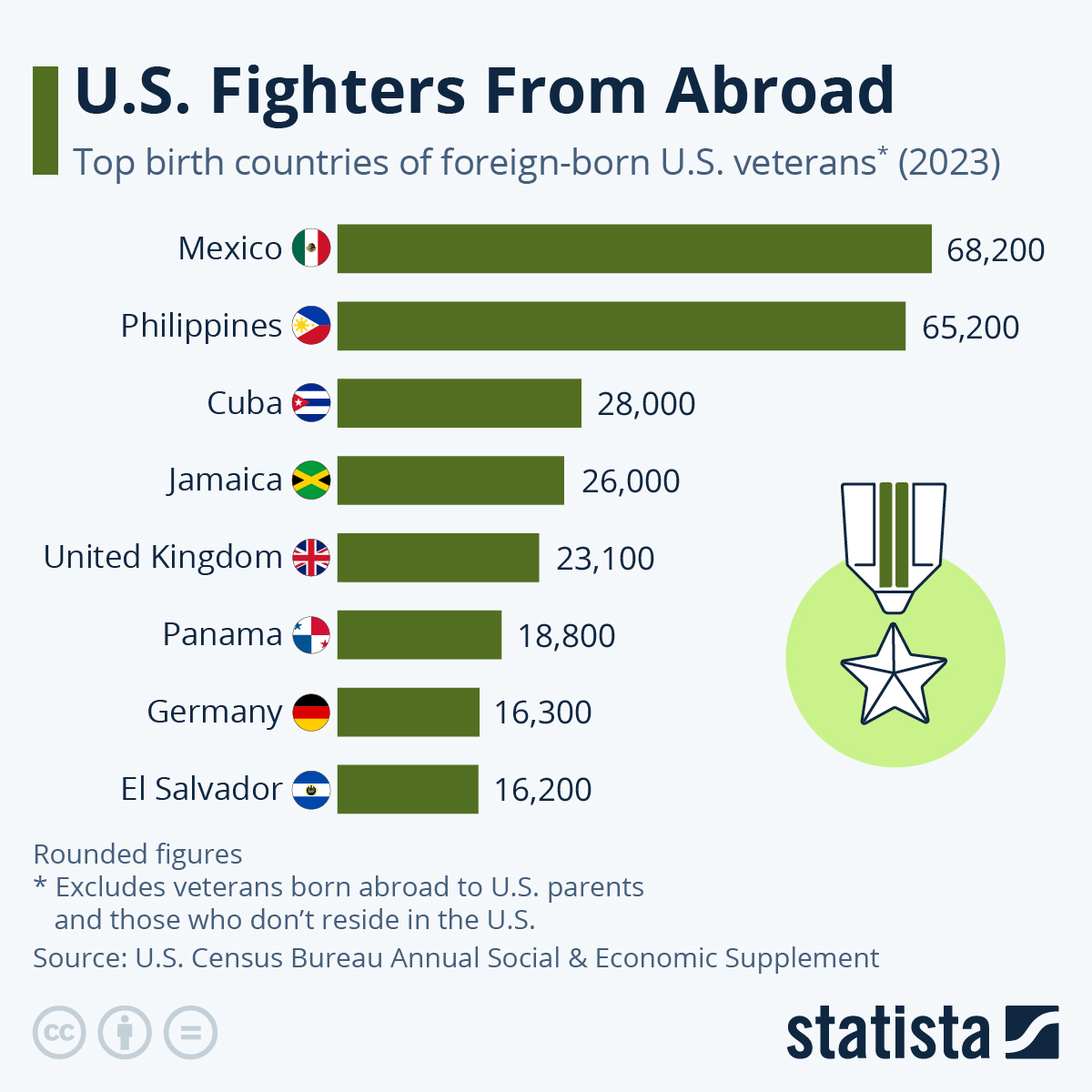
Around 3.5 percent, or 600,000 people belonging to the U.S. veteran population were born outside the United States to foreign parents, according to the U.S. Census Bureau.
According to Migration Policy, another 2 million are the children of immigrants to the country.
As Statista's Katharina Buchholz reports, among the foreign-born ex-recruits, natives of Mexico and the Philippines are by far the biggest groups, according to the U.S.-based survey.
You will find more infographics at Statista
The size of the latter group might be a surprise for some Americans, but the U.S. and the Philippines share a long military history going back to World War II when the Southeast Asian country was considered a Commonwealth of the United States.
The real number of Philippines-born veterans of the U.S. armed forces can be expected to be even higher than indicated in the U.S. based survey. The U.S. has not granted citizenship to most of those it recruited in the Philippines during World War II despite initially promising to do so, blocking their path to immigration and resulting in them not being counted by the U.S. Census. Because of the Commonwealth status of the Philippines at the time, a sizable immigrant population consisting mainly of young men was already living in the United States in the 1930s and 1940s. Many of these enlisted as well and were granted citizenship.
Due to the World War II history of their enlistment, 18,000 of the 65,000 Filipino U.S. vets are currently over the age of 75. The progressing age of World War II veterans is also the reason why the number of Filipino vets of the U.S. forces has been dwindling. In 2018, there were still as many as 91,000. Yet, there are Philippines-born U.S. vets of all ages in the U.S. as immigration from the Philippines remained at a high level after independence.
Likewise, the number of German and British vets has been decreasing majorly in recent years. On the other hand, the number of veterans from the United States' neighbors, Mexico and Canada, has been growing.
The numbers taken from the U.S. Census Bureau's Annual Social and Economic Supplement and made available online by the University of Minnesota exclude veterans born to U.S. parents abroad.
Around 3.5 percent, or 600,000 people belonging to the U.S. veteran population were born outside the United States to foreign parents, according to the U.S. Census Bureau.
According to Migration Policy, another 2 million are the children of immigrants to the country.
As Statista’s Katharina Buchholz reports, among the foreign-born ex-recruits, natives of Mexico and the Philippines are by far the biggest groups, according to the U.S.-based survey.
You will find more infographics at Statista
The size of the latter group might be a surprise for some Americans, but the U.S. and the Philippines share a long military history going back to World War II when the Southeast Asian country was considered a Commonwealth of the United States.
The real number of Philippines-born veterans of the U.S. armed forces can be expected to be even higher than indicated in the U.S. based survey. The U.S. has not granted citizenship to most of those it recruited in the Philippines during World War II despite initially promising to do so, blocking their path to immigration and resulting in them not being counted by the U.S. Census. Because of the Commonwealth status of the Philippines at the time, a sizable immigrant population consisting mainly of young men was already living in the United States in the 1930s and 1940s. Many of these enlisted as well and were granted citizenship.
Due to the World War II history of their enlistment, 18,000 of the 65,000 Filipino U.S. vets are currently over the age of 75. The progressing age of World War II veterans is also the reason why the number of Filipino vets of the U.S. forces has been dwindling. In 2018, there were still as many as 91,000. Yet, there are Philippines-born U.S. vets of all ages in the U.S. as immigration from the Philippines remained at a high level after independence.
Likewise, the number of German and British vets has been decreasing majorly in recent years. On the other hand, the number of veterans from the United States’ neighbors, Mexico and Canada, has been growing.
The numbers taken from the U.S. Census Bureau’s Annual Social and Economic Supplement and made available online by the University of Minnesota exclude veterans born to U.S. parents abroad.
Loading…






